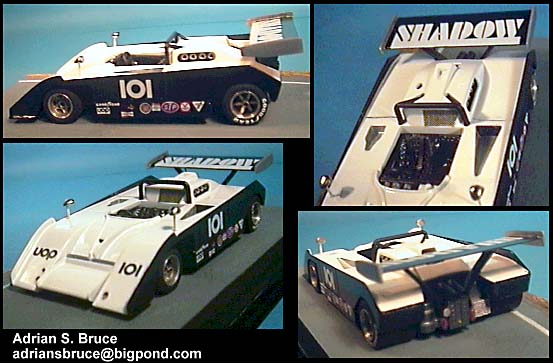1971 CAN-AM Shadow MKII
Build article by Adrian S. Bruce


The base kit was an ESDO Shadow MKII. The main changes were the construction of the proper 2-seat interior, wheel sizes and correcting the shape of the rear wheel wells. Reference photos used were from the Pete Lyons Can-Am and Can-Am Photo History books. The car changed from completely black to 2 tone during the season, and this model represents the later version. The designer, Peter Bryant, found that making the car white made it significantly cooler for the systems and driver, Jackie Oliver.
Wheels and axles
The supplied axle rods were far too thin to produce straight and true wheel alignment and wheel well clearances. The rear white metal rims had the inside, inner sections filled with polyester putty and drilled to accept a larger brass rod for the axle shaft. Tire diameters and proportions were also changed by sanding them while attached to the shaft from a saw bit in a mini drill. This was done to make the car have that low, small wheel look. Rims were airbrushed a gold mix.
Body
The rear wheel openings were corrected with sheet styrene, polyester putty and files. The opening in front of the rear wheel was too rounded and extended too ar forward in the original kit. The rear axle location was also slightly changed and the ride height adjusted to suit the modified wheels and axles.
The supplied white metal rear view mirrors had the long storks cut off, and small holes drilled to fit suitable brass rod. The mirrors themselves were them polished while the rod was primed and painted white separately. The mirror faces were painted silver. This solved the problem of polishing one section, and having the other white and perfectly straight and round in the small parts.
The rear wing had many imperfections that where finally filled with putty and the unit painted in aluminum and black. Getting the wing supports to sit straight and support the wing was a tedious process. They are not stable enough to support the wing without twisting in their support locations. Brass rod was added to one side of the support for the wing tilt mechanism.
The body was painted in Tamiya gloss white and black spray cans. Inside the vents in the top bodywork painted with enamel aluminum.
Engine
Cut off and reshaped the distributor and moved it to its correct location and added ignition lines, even though they are barely visible in the completed model. Detail painting was done with Tamiya enamels in blacks, red, gunmetal and aluminum.
Cockpit
ESDO supplies the wrong seat unit with the wrong padding pattern. A mold was taken of a seat from another CAN-AM kit by pressing it into some silicon putty. 2 Seats were then cast in polyester putty. These where then cut down width-ways, glued together, and the correct shaped 2 seat unit formed with more putty and sanding. The drivers seat vinyl padding was sculpted from Tamiya epoxy putty.
Seat belt is a p-e Tameo 6-point harness cut to make it 5-point. Dash is 0.3mm brass, with instruments from the decal sheet. The rear of the instruments are very visible in the reference photos and were made from sections cut from stretched spruce and some fine wire. Steering wheel column was cut off and brass rod used instead. Finished in Flat Black, Flat White, Satin Black and Flat Aluminum.
Decals
Decals applied and those going over tight curves were hit with some decal solvent. Tire markings are from an aftermarket tire decal set.
Base
12mm plywood cut with a jig saw. Road is 800 wet and dry sprayed a dark
gray. Road markings in Liquitex artists acrylics, using drafting tape as
a mask and dry brushing the paint on to get a worn look. Ground work built
up with Liquitex medium, grass and dirt being the stuff intended for use
in small scale model railway layouts.